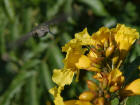Anyone who knows me well knows that I am an avid hummingbird enthusiast, so I am often asked a wide variety of questions on the subject of hummingbirds and topics which also relate to hummingbirds. It truly thrills me to be able to answer these type of questions. Here recently a number of people have ask me about the proper placement of their hummingbird feeders, so that is what has prompted me to write today’s post.
There is no such thing as the “perfect” spot to place your hummingbird feeder. You can place your feeder anywhere you would like, but my recommendation would be to place the feeder in a location where you can see it from a window in your home and also somewhere it is easy to get to because you will have to clean and refill it quite frequently. If you make this task to difficult you will not do it and then you would not get to enjoy the hummingbirds.
The easiest thing to do is to hang the feeder from a tree. The birds like this because it allows them to perch on the branches, which act as a form of cover for the birds, and then whenever the birds wish it is easy for them to fly to the feeder and get a drink.
Another suggestion is to hang your feeder a few feet from a birdbath. Since hummingbirds enjoy water sources, the birds will likely want to get a drink or clean themselves before or after eating and this is a way to try and increase the activity at your feeders.
You will want to place your feeders out of the wind and sun. Hanging the feeder where there is too much wind can cause the nectar solution to possibly slosh out of the feeder due to the windy conditions. Placing feeders directly in an area that receives too much sunlight can cause the nectar solution to ferment or spoil too rapidly. This can harm the hummingbirds and cause the birds to no longer trust your food source. If a feeder is made of plastic, too much sun exposure will cause the plastic to crack and fade as a result of prolonged exposure to the sunlight.
A hummingbird feeder should never be placed too close to a window. If the feeder is placed to close to a window, it is possible that the bird may fly into the window by mistake and then either stun or kill itself.
Cats are the number one predator of the hummingbird. In an effort to ensure that your cat is unable to harm the hummingbirds, your feeder should be placed well up off the ground. One source that I read suggested that five feet was the recommended height for a feeder if there are cats in the area.
As you can see from reading this post, there is no such thing as the “perfect” spot in which to place your hummingbird feeder. Keeping these suggestions in mind will help you attract the greatest number of hummingbirds possible as well as being able to enjoy these wonderful birds to the fullest.

